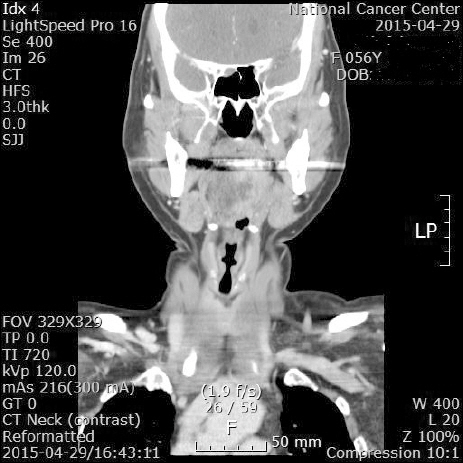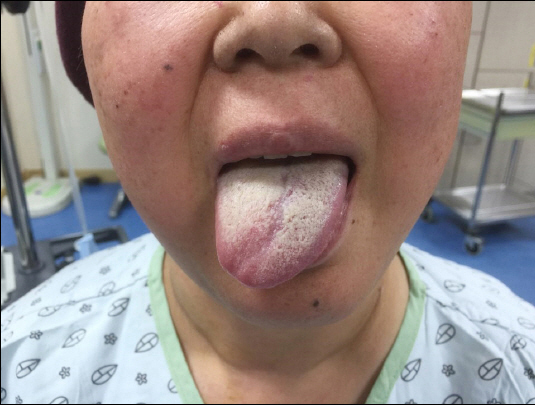Anesth Pain Med.
2016 Apr;11(2):220-223. 10.17085/apm.2016.11.2.220.
Unilateral hypoglossal nerve palsy after endotracheal intubation for general anesthesia in a difficult airway patient: A case report
- Affiliations
-
- 1Department of Anesthesiology and Pain Medicine, National Cancer Center, Goyang, Korea. hiha3758@ncc.re.kr
- 2Department of Otorhinolaryngology, National Cancer Center, Goyang, Korea.
- KMID: 2358490
- DOI: http://doi.org/10.17085/apm.2016.11.2.220
Abstract
- Hypoglossal nerve palsy after general anesthesia is an exceptionally rare complication, which has varied etiology. We present a case of unilateral hypoglossal nerve palsy resulting from repeated airway intervention for general anesthesia. A 57-year-old woman was scheduled to undergo modified radical mastectomy. During endotracheal intubation, the patient had Cormack's grade III-a severe airway condition. After the first intubation attempt failed, the intubation was attempted a second time using a stylet inside the endotracheal tube with cricoid pressure; this attempt was successful. In the evening of the operation day, the patient complained of dysarthria and dysphagia. Physical examination revealed deviation of the tongue to the right, which may have been caused by traumatic hypoglossal nerve injury. This case reviews the pathophysiology, prevention, and management of hypoglossal nerve palsy.
MeSH Terms
Figure
Reference
-
1. Hong SJ, Lee JY. Isolated unilateral paralysis of the hypoglossal nerve after transoral intubation for general anesthesia. Dysphagia. 2009; 24:354–6. DOI: 10.1007/s00455-008-9197-5. PMID: 18853225.
Article2. FitzGerald MJ, Gruener G, Mtui E. Clinical neuroanatomy and neuroscience. 2012. 6th ed. Philadelphia: Saunders/Elsevier;p. 216.3. Cinar SO, Seven H, Cinar U, Turgut S. Isolated bilateral paralysis of the hypoglossal and recurrent laryngeal nerves (Bilateral Tapia’s syndrome) after transoral intubation for general anesthesia. Acta Anaesthesiol Scand. 2005; 49:98–9. DOI: 10.1111/j.1399-6576.2004.00553.x. PMID: 15675991.
Article4. Dziewas R, Lüdemann P. Hypoglossal nerve palsy as complication of oral intubation, bronchoscopy and use of the laryngeal mask airway. Eur Neurol. 2002; 47:239–43. DOI: 10.1159/000057906. PMID: 12037439.
Article5. Hung NK, Lee CH, Chan SM, Yeh CC, Cherng CH, Wong CS, et al. Transient unilateral hypoglossal nerve palsy after orotracheal intubation for general anesthesia. Acta Anaesthesiol Taiwan. 2009; 47:48–50. DOI: 10.1016/S1875-4597(09)60022-9.
Article6. Keane JR. Twelfth-nerve palsy. Analysis of 100 cases. Arch Neurol. 1996; 53:561–6. DOI: 10.1001/archneur.1996.00550060105023.7. Chung MY, Kim CJ, Chea JS, Lee MN, Lee BH. The two stage flexible fiberoptic bronchoscoptic awake intubation in a patient with the symptomatic vallecular cyst: a case report. Anesth Pain Med. 2011; 6:146–9.8. Garcia J, Coste A, Tavares W, Nuño N, Lachapelle K. Assessment of competency during orotracheal intubation in medical simulation. Br J Anaesth. 2015; 115:302–7. DOI: 10.1093/bja/aev207. PMID: 26170352.
Article9. Mullins RC, Drez D Jr, Cooper J. Hypoglossal nerve palsy after arthroscopy of the shoulder and open operation with the patient in the beach-chair position. A case report. J Bone Joint Surg Am. 1992; 74:137–9. PMID: 1734004.
Article10. Lagalla G, Logullo F, Di Bella P, Provinciali L, Ceravolo MG. Influence of early high-dose steroid treatment on Bell’s palsy evolution. Neurol Sci. 2002; 23:107–12. DOI: 10.1007/s100720200035. PMID: 12391494.11. Shah AC, Barnes C, Spiekerman CF, Bollag LA. Hypoglossal nerve palsy after airway management for general anesthesia: an analysis of 69 patients. Anesth Analg. 2015; 120:105–20. DOI: 10.1213/ANE.0000000000000495. PMID: 25625257. PMCID: PMC4308816.12. Guha K, Sabarigirish K, Singh SK, Yadav A. Role of laryngeal electromyography in predicting recovery after vocal fold paralysis. Indian J Otolaryangol Head Neck Surg. 2014; 66:394–7. DOI: 10.1007/s12070-014-0723-5. PMID: 26396950. PMCID: PMC4571471.
Article
- Full Text Links
- Actions
-
Cited
- CITED
-
- Close
- Share
- Similar articles
-
- Isolated Unilateral Hypoglossal Nerve Palsy Following Transoral Endotracheal Intubation for Endoscopic Sinus Surgery
- Compression Neuropathy of the Hypoglossal Nerve Following Orotracheal Intubation: A case report
- Hypoglossal Nerve Palsy following General Anesthesia: A case report
- Transient Hypoglossal Nerve Palsy after Septorhinoplasty: A case report
- Transient Hypoglossal Nerve Palsy after General Anesthesia in Beach Chair Position for Shoulder Arthroscopic Bankart Repair: A case report



